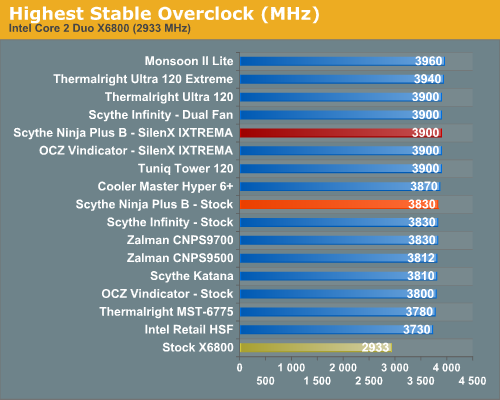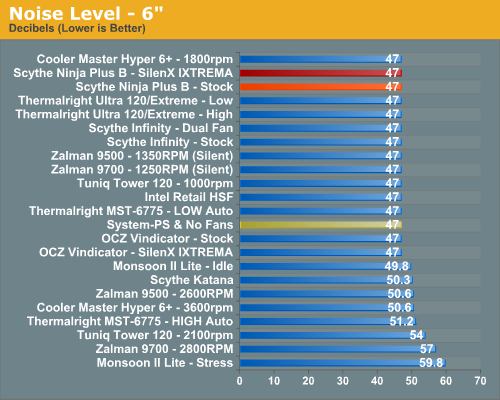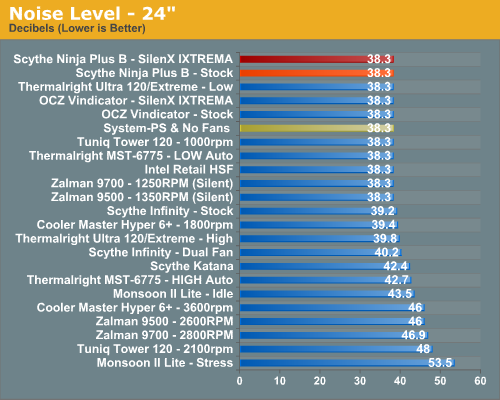Scythe Ninja Plus Rev. B: Updated Cooling Legend
by Wesley Fink on April 11, 2007 2:00 AM EST- Posted in
- Cases/Cooling/PSUs
Overclocking
As cooling solutions do a better job of keeping the CPU at a lower temperature, it is reasonable to expect the overclocking capabilities of the CPU will increase. In each test of a cooler we measure the highest stable overclock of a standard X6800 processor under the following conditions:
CPU Multiplier: 14x (Stock 11x)
CPU voltage: 1.5875V
FSB Voltage: 1.30V
Memory Voltage: 1.90V
nForce SPP Voltage: 1.35V
nForce MCP Voltage: 1.7V
HT nForce SPP <-> MCP:
Auto
Memory is set to Auto timings on the 680i and memory speed is linked to the FSB for the overclocking tests. This removes memory as any kind of impediment to the maximum stable overclock. Linked settings on the 680i are a 1066FSB to a memory speed of DDR2-800. As FSB is raised the linked memory speed increases in proportion. The same processor is used in all cooling tests to ensure comparable results.

The Scythe Ninja Plus B with the stock fan could only reach 3.83GHz overclock with stability. This is a little better OC than the OCZ Vindicator with the stock fan and matches the performance of the Scythe Infinity with a single stock fan. It is not, however, performance comparable to the top tier of the heatpipe towers tested.
However a change to the 72 CFM 14 dB-A SilenX IXTREMA 120 allowed us to push the overclock to 3.90GHz with complete stability. This does match the top tier of overclocks achieved by the Tuniq Tower 120, Thermalright Ultra 120/Scythe SFLEX, OCZ Vindicator (with SilenX), and Scythe Infinity with dual push-pull fans.
The only air cooler that has reached higher than 3.90GHz is the Thermalright Ultra 120 Extreme, which was featured at CeBIT. We managed 3.94GHz with that top air cooler. The hybrid TEC/air Monsoon II Lite reached 3.96GHz in benchmarking, but that cooler combines active TEC cooling with passive air cooling and would be expected to reach higher overclocks than an air alone solution.
Noise
For many enthusiasts upgrading cooling the goal is maximum stable overclock, and they will live with the inconvenience of a louder system. For other users silence is the most important factor, and these users will forgo maximum overclocking if that increases system noise levels.
We measured noise levels with the Scythe Ninja Plus B with both stock and SilenX IXTREMA fans under both load and idle conditions. The fans have specified noise ratings of 20.9 dB-A and 14 dB-A, and the measured noise with both fans was below our system noise floor at both 6" and 24" positions above the open side of our system case.
There are virtually no power supplies that do not include a fan. While Zalman and a few others do make an expensive fanless power supplies, we have not seen a fanless unit larger than 500W, or one that would be used for seriously overclocking a system. With that in mind the noise level of the system with all fans turned off except the power supply was measured. The power supply used for the cooling test bed was the OCZ PowerStream 520, which is one of the quieter of the high performance power supplies.
We have also measured the Corsair 620-watt and Mushkin 650-watt power supplies which are reported to be quieter than the OCZ. Both the Corsair and Mushkin are indeed quieter at idle or start up speed. However, as soon as load testing begins and the PSU fan speed kicks up the measured noise level is almost exactly the same as the OCZ PowerStream 520 watt power supply.
We are currently in the process of evaluating "quieter" power supplies for an update to our cooler test bed. We will make changes to that test bed as soon as we are confident in the noise measurements and test procedures with a variable speed quiet PSU. We plan to evaluate additional power supplies and configurations in our upcoming 120mm fan roundup, at which point we will complete the transition to a revised and lower noise cooler test bed.
The noise level of the power supply was 38.3 dB from 24" (61cm) and 47 dB from 6" (152mm). The measured noise level of the test room is 36.4 dB, which would be considered a relatively quiet room with a noise floor slightly below the OCZ PowerStream 520 PSU.


Measured noise levels in this chart should be considered worst case. Measurements were taken with an open side of a mid tower case 6" and 24" from the HSF. Real world would be a completely closed case resulting in a further reduction in noise.
Any 120mm fan that is a standard 25mm thick should be mountable on the Scythe Ninja Plus B. The fan clips connect to the outside mount hole, which means both open post and the more common closed post fans will work properly. The stock Ninja fan is closed post and the SilenX is open post. This means the SilenX will work on any cooler we have reviewed thus far - including the Thermalright Ultra 120 and Ultra 120 Extreme.
As cooling solutions do a better job of keeping the CPU at a lower temperature, it is reasonable to expect the overclocking capabilities of the CPU will increase. In each test of a cooler we measure the highest stable overclock of a standard X6800 processor under the following conditions:
CPU Multiplier: 14x (Stock 11x)
CPU voltage: 1.5875V
FSB Voltage: 1.30V
Memory Voltage: 1.90V
nForce SPP Voltage: 1.35V
nForce MCP Voltage: 1.7V
HT nForce SPP <-> MCP:
Auto
Memory is set to Auto timings on the 680i and memory speed is linked to the FSB for the overclocking tests. This removes memory as any kind of impediment to the maximum stable overclock. Linked settings on the 680i are a 1066FSB to a memory speed of DDR2-800. As FSB is raised the linked memory speed increases in proportion. The same processor is used in all cooling tests to ensure comparable results.

The Scythe Ninja Plus B with the stock fan could only reach 3.83GHz overclock with stability. This is a little better OC than the OCZ Vindicator with the stock fan and matches the performance of the Scythe Infinity with a single stock fan. It is not, however, performance comparable to the top tier of the heatpipe towers tested.
However a change to the 72 CFM 14 dB-A SilenX IXTREMA 120 allowed us to push the overclock to 3.90GHz with complete stability. This does match the top tier of overclocks achieved by the Tuniq Tower 120, Thermalright Ultra 120/Scythe SFLEX, OCZ Vindicator (with SilenX), and Scythe Infinity with dual push-pull fans.
The only air cooler that has reached higher than 3.90GHz is the Thermalright Ultra 120 Extreme, which was featured at CeBIT. We managed 3.94GHz with that top air cooler. The hybrid TEC/air Monsoon II Lite reached 3.96GHz in benchmarking, but that cooler combines active TEC cooling with passive air cooling and would be expected to reach higher overclocks than an air alone solution.
Noise
For many enthusiasts upgrading cooling the goal is maximum stable overclock, and they will live with the inconvenience of a louder system. For other users silence is the most important factor, and these users will forgo maximum overclocking if that increases system noise levels.
We measured noise levels with the Scythe Ninja Plus B with both stock and SilenX IXTREMA fans under both load and idle conditions. The fans have specified noise ratings of 20.9 dB-A and 14 dB-A, and the measured noise with both fans was below our system noise floor at both 6" and 24" positions above the open side of our system case.
There are virtually no power supplies that do not include a fan. While Zalman and a few others do make an expensive fanless power supplies, we have not seen a fanless unit larger than 500W, or one that would be used for seriously overclocking a system. With that in mind the noise level of the system with all fans turned off except the power supply was measured. The power supply used for the cooling test bed was the OCZ PowerStream 520, which is one of the quieter of the high performance power supplies.
We have also measured the Corsair 620-watt and Mushkin 650-watt power supplies which are reported to be quieter than the OCZ. Both the Corsair and Mushkin are indeed quieter at idle or start up speed. However, as soon as load testing begins and the PSU fan speed kicks up the measured noise level is almost exactly the same as the OCZ PowerStream 520 watt power supply.
We are currently in the process of evaluating "quieter" power supplies for an update to our cooler test bed. We will make changes to that test bed as soon as we are confident in the noise measurements and test procedures with a variable speed quiet PSU. We plan to evaluate additional power supplies and configurations in our upcoming 120mm fan roundup, at which point we will complete the transition to a revised and lower noise cooler test bed.
The noise level of the power supply was 38.3 dB from 24" (61cm) and 47 dB from 6" (152mm). The measured noise level of the test room is 36.4 dB, which would be considered a relatively quiet room with a noise floor slightly below the OCZ PowerStream 520 PSU.


Measured noise levels in this chart should be considered worst case. Measurements were taken with an open side of a mid tower case 6" and 24" from the HSF. Real world would be a completely closed case resulting in a further reduction in noise.
Any 120mm fan that is a standard 25mm thick should be mountable on the Scythe Ninja Plus B. The fan clips connect to the outside mount hole, which means both open post and the more common closed post fans will work properly. The stock Ninja fan is closed post and the SilenX is open post. This means the SilenX will work on any cooler we have reviewed thus far - including the Thermalright Ultra 120 and Ultra 120 Extreme.










36 Comments
View All Comments
Pirks - Wednesday, April 11, 2007 - link
I'm going to get myself a monster of a heatsink called Cooler Master GeminII. It has two 120mm fans on top that blow right down on the mobo. On the other hand I keep reading all these news here coming from Gary, Wesley, Jarred and the gang, that tower coolers like Infinity or Thermalright kick ass and yield only to waterblocks. Now, the question is - are you guys really missing this important part of cooling mosfets, power circuitry, some northbridge, memory etc? Or is it really unimportant?I mean, what's the point in having such an imbalanced cooling solution where the CPU is cool but evetything else is almost melting? I recall my experience with Athlon XP in a tight poorly ventilated case - I put Zalman on it instead of a little tower HSF and you you know what? The power circuitry temperature went down 16 degrees right there, and I stopped getting Windows freezing on me. Stability became just like on those pesky Macs (j/k) :)
So what is it? A vertical tower? Or a horizontal cooler that blows on mosfets? Or a mix of both with tower and additional coolers around it to cool mosfets?
At least a link to some systematic research won't hurt, I can only see opinionated forums where half of the population says towers suck because they don't cool mosfets and the other half says towers rock precisely because they don't cool mosfets :) Wesley? Gary? Any other AT overclocking guru? What's your opinion and arguments for it (or against it)?
LaGUNaMAN - Thursday, April 12, 2007 - link
Speaking of the Cooler Master GeminII, requesting to have that reviewed as well. Great job on the article BTW Bozz Wesley. Can't wait for the 120mm fan roundup. (^^,)Wesley Fink - Friday, April 13, 2007 - link
The CoolerMaster Gemini II is in the lab for review. I agree it looks really promising with a pair of low-noise high-output fans. We hope to get to it within the next couple of weeks.Kaleid - Saturday, April 14, 2007 - link
Could you try placing one fan in the middle of that cooler? Does it really perform better with two fans or would one silent fan do the trick?Stele - Wednesday, April 11, 2007 - link
That's a very good question, one which I've often asked myself when looking for coolers. Granted, a straight-through airflow right out the back of the casing helps prevent a build-up of warm air inside it, but that would leave a weak level of airflow around the other hotspots on the motherboard... especially with the likes of a 680i SLI overclocked.
It would be terrific if Anandtech could deploy a few thermocouple probes or even an IR thermometer and measure the temperatures of those hotspots - PWM heatsink (or PWM MOSFET if no heatsink present), northbridge, and if time allows, perhaps even the side of a RAM DIMM and graphics card nearest the CPU socket area. That would certainly help differentiate the coolers good at just cooling the CPU from those that can do better overall. :)
noobzter - Wednesday, April 11, 2007 - link
1. How does the CPU temp as reported in NTune compare to TAT's?2. What was the ambient temp during the test?
noobzter - Thursday, April 12, 2007 - link
Sweet, thanks!Wesley Fink - Thursday, April 12, 2007 - link
TAT workload testing with the stock Scythe fan on the Ninja Plus B show test results virtually the same at TAT 80% CPU load as our 30 minute gaming tests. Since you are likely familiar with TAT results that info may be useful. TAT does stress both cores in testing, which our current game tests do not do.Wesley Fink - Thursday, April 12, 2007 - link
1. TAT (Thermal Analysis Tool) is an Intel program, so it did not occur to us to use it for verification on an nVidia chipset. However, it is CPU centric, and we found it DOES work on the 680i chipset. Comparing Idle temps to nVidia Monitor results at 3.73GHz overclocked showed reported Monitor and TAT temps within 0-2C of each other. We will test more with TAT using internal load tests in the future.2. Ambient room temperature during tests is 70F (21C).
iluvdeal - Wednesday, April 11, 2007 - link
I am looking for a quiet HSF which allows good OCing for a Core2Duo and the Ninja fits that bill, however the one thing that's constantly repeated about it is it's difficult to securely mount with a S775. That's what scared me away from it.